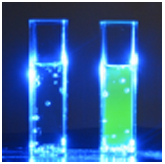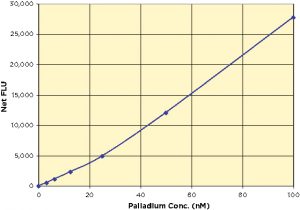Palladium Detection for API Purification
Features:
- 30 Minute Assay
- HTS Compatible 96 Well Plate Format
- Works with APIs in HCl. NMP, MeCN, DMF, Ethanol, and Toluene
- Sensitivity 0.082 nM
- Detection with any Fluorescent Plate Reader
Many new synthetic transformations have been developed that use palladium (Pd) compounds for the catalysis of carbon-carbon and carbon-heteroatom coupling reactions such as the Buchwald-Hartwig, Heck, Kumada, Negishi, Nozaki-Hiyama, Sonogashira, Stille, SuzukiMiyaura, and Tsuji-Trost transformations. These reactions have found increased popularity for pharmaceutical processes as they utilize a wide-range of functional groups and can therefore be used to build complicated molecules. However, palladium-catalyzed reactions present a problem – the palladium can often be retained in the isolated product. The LD50 values are very dependent on the physical form of the Pd compounds or catalysts used. For rats, mice, or rabbits, water soluble PdCl2 administered intravenously gave a LD50 of 3 mg/kg body weight while relatively insoluble PdO given orally gave an LD50 >4900 mg/kg body weight. Current European Agency for the Evaluation of Medicinal Products regulations limit all platinum group (Pt, Pd, Ir, Rh, Ru, Os) metal contamination (as a group) to less than 5 ppm. A variety of methods are available for removing Pd from active pharmaceutical ingredients (APIs). These include adsorption with trimercaptotriazine N-acetylcysteine as solids removed by filtration, on polymeric supports such as polystyrene, or as macroporous resins such as the Isolute resins (Biotage). Other adsorptive methods include activated carbon, ion exchange type resins, fiberous materials such as Smopex™ (Johnson Matthey), and silica bound active resins from SiliCycle. Typical chemical purification methods such as crystallization can also be used to lower the concentration of Pd in the final product, especially when combined with additives such as the sulfur containing ligands, N-acetylcysteine and thiourea, and with phosphines to keep the Pd in the mother liquor. The standard methods of quantifying palladium in APIs are atomic absorption analysis, x-ray fluorescence, and plasma emission spectroscopy such as inductively-coupled plasma mass spectroscopy (ICP-MS). ICP-MS is typically used both during synthesis and for final QC on drug molecules. These methods require expensive instruments with a highly trained scientist to operate. Cross-contamination of the instrument can limit the throughput of this analysis and requires scrupulous clean up methodology. In developing methods for purification protocols for APIs, the use of ICP-MS is a limit on high throughput analysis of Pd levels.
The PdX® Palladium (Pd) Detection kit is designed to allow the rapid determination of relative amounts of Pd present in active pharmaceutical ingredient (API) scavenging steps. The kit uses a patent-pending, exclusively licensed non-fluorescent detection molecule that, under reducing conditions, palladium cleaves to yield a brightly fluorescent product.
The relative concentrations of Pd in the sample from scavenging methods for removal of Pd is calculated after making a suitable correction for dilution of the sample using software available with most plate readers. In some Pd catalyst-API combinations the interaction between the Pd atom and the API molecule may be so strong that the Pd catalyst will not reduce the allyl moiety on the sensor. In these cases we suggest microwave digestion of the API prior to running the fluorescent assay.
This assay is intended to be used to evaluate scavenger methods for removing palladium catalysts from API materials.. It is suggested that a reference level of the palladium content in the starting API prior to evaluation of scavenging methods be determined using ICP-MS or similar method and that this level is compared to the concentration determined using this kit as a baseline for determining the efficiency of Pd removal. Scavenger methods can then be assessed by evaluating decreases in fluorescent signal for each method. This kit is NOT intended to be used as a replacement to ICP-MS for final product validation.



